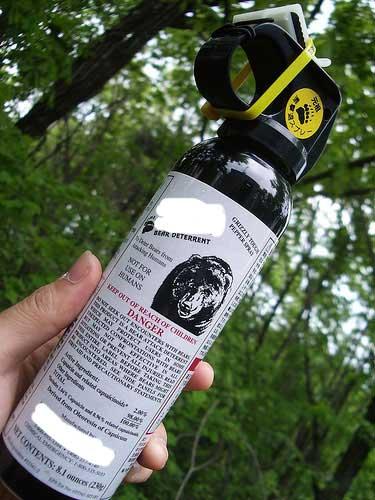A popular series of TV commercials asks "What's in your wallet?" but sometimes it's more important to remember what you're carrying next to your wallet. That was certainly the case recently at Grand Teton National Park when a park visitor accidentally set off a canister of bear spray inside a visitor center.
Bear spray has a proven track record as a defensive measure against bear attacks, but the recent miscue provided a reminder about the importance of following the instructions for safely carrying such products. The apparently accidental discharge of pepper spray forced the evacuation of the visitor center at Colter Bay earlier this month.
According to a park report, as a ranger was greeting visitors for a morning program in the visitor center auditorium a man sat down on what was apparently an unsecured canister of bear spray. This caused the can to discharge its contents of highly irritating spray into the room.
The active ingredient in most bear spray products is capsaicin and related capsaicinoids, similar to the pepper spray carried by law enforcement officers—but with a higher percentage of the irritant.
The ranger immediately recognized what had happened and directed all the occupants of the room to the emergency exits.
Park emergency personnel were notified of the incident since the building’s air handling systems carried the residual pepper spray into the main lobby. The first emergency units to arrive found approximately 20 employees and visitors in the main lobby coughing and experiencing other side effects from the pepper spray.
Incident command was established and the building was evacuated. While emergency medical staff evaluated both employees and visitors, structural fire personnel in full Personal Protective Equipment began ventilating the building. All the affected individuals declined medical treatment.
Visitor services were continued through the rest of the day at portable tables in front of the visitor center while cleanup was begun by facility management staff. That cleanup, however, proved to be a challenging task.
The irritant in the spray is dispersed in an oil-based aerosol that clings to any surface it contacts, including vinyl, plastics, carpeting, clothing and human skin. An additional challenge involved the merchandise in the building's gift shop. The cooperating association staff bagged and sealed many soft items, such as t-shirts and stuffed animals, for decontamination at a later date.
It's unknown whether it was a case of guilty conscience or simple panic, but the visitor who discharged the bear spray ran from the room and building. Rangers were unsuccessful in locating the man, but statements from the interpreter in the room and other visitors indicate that the discharge was accidental. The visitor center was reopened the following day.
The incident is a good reminder that anyone who purchases a product such as bear pepper spray needs to read—and heed—the instructions. A video from Yellowstone National Park on use of bear pepper spray notes that "a good bear pepper spray will have a safety clip on the trigger. This prevents accidental discharge." You can view that video at this link, or just read the transcript here.


 Support Essential Coverage of Essential Places
Support Essential Coverage of Essential Places







Comments
What a coward to run-----guess it shows what kind of man he is
Heck if a can went off, I would run as well, but I would be sure to come back after disapation so that nobody thinks it was a deliberate act, but I can tell you what anytime a can of bear spray goes off I am hightailing it out of there! Yikes!
This National Parks Traveler story picked up and cited by Public Radio --
Thanks Jim Burnett and all the team for running this story, and getting cited on Public Radio. It was a pleasure one morning being awakened by my radio quoting National Parks Traveler and this story you ran.
Thanks to National Parks Traveler for getting more national park stories out there!
Bear spray? This is --illegal-- on National Parks property.
Under 36CFR 1.4
Weapon means a firearm, compressed gas or spring-powered pistol
or rifle, bow and arrow, crossbow, blowgun, speargun, hand-thrown spear,
slingshot, ---irritant gas device---, explosive device, or any other
implement designed to discharge missiles, and includes a weapon the
possession of which is prohibited under the laws of the State in which
the park area or portion thereof is located.
2.4 prohibits weapons
It is however legal to have a loaded firearm in a national park provided it's legal in the state the park resides in. I've heard from some sources that some Park Superintendents are circumventing CFR by "declaring" that bear spray is allowed. This is illegal.
"Whether or not the general public may carry weapons in a given park is
not a discretionary decision made by the park superintendent under
regulation 1.5(a), but instead is a decision controlled by the statutes
and regulations governing that park."
http://caselaw.findlaw.com/us-4th-circuit/1287084.html
It is OK if the park superintendent has published an exception that allows for specific "weapons" to be possessed by the public. I believe bear spray is specifically exempted from weapons regulations in parks with grizzly bears, including Yellowstone, Grand Teton, and Glacier.
http://www.nps.gov/yell/planyourvisit/upload/supt_compendium.pdf
Bear spray is specifically mentioned as illegal in Yosemite NP:
http://www.nps.gov/yose/planyourvisit/weapons.htm
This was also mentioned on NPT:
/2009/04/many-national-parks-recommend-bear-spray-apparently-are-breaking-law